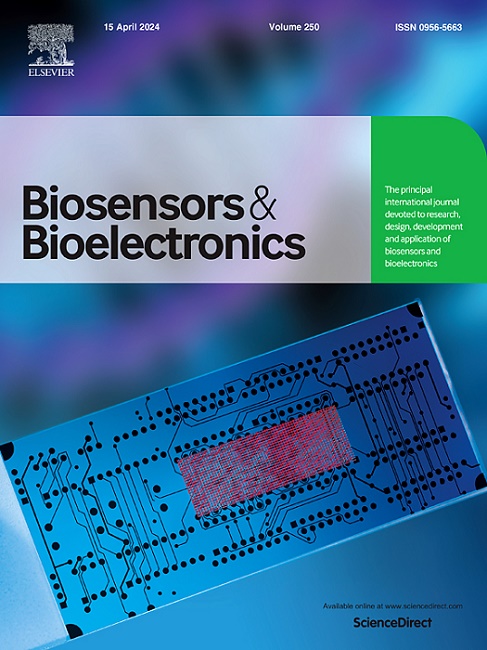dna -聚精氨酸探针纳米孔传感用于坝甲基转移酶活性和抑制的超灵敏检测
IF 10.5
1区 生物学
Q1 BIOPHYSICS
引用次数: 0
摘要
异常DNA甲基转移酶(DNA MTase)活性与各种癌症中观察到的异常DNA甲基化模式相关,使DNA MTase成为早期临床诊断和抗癌/抗菌治疗的治疗靶点。目前的DNA MTase检测方法仍然很费力,并且在技术上具有挑战性。本研究提出了一种利用dna -聚精氨酸(DNA-R5)探针的无标记、单分子纳米孔传感策略,用于灵敏的Dam MTase检测。DNA- r5独特的振荡模式有助于特异性,而其他DNA结构无法输出这种特征。在这里,发夹DNA-R5释放单链DNA-R5,随后进行Dam甲基化和DpnI切除,从而转化为振荡信号。实验验证了突变体蛋白定位、发夹环长度、pH依赖电荷维持和电渗透平衡电压的优化,其中pH 8.0在140 mV时被确定为信号产生的最佳条件。磁珠的综合使用可将Dam的检出限降低至0.00005 U/mL。稀释的人血清验证证实了该分析的实施,而青霉素抑制研究证明了该平台的药物发现潜力。我们提出的方法显示了临床诊断的前景,DNA-R5作为未来治疗目标分析的多功能探针,下一个大规模临床试验的计划是测试患者血清中的细菌裂解物,并跟踪药物治疗前后的大坝进展。本文章由计算机程序翻译,如有差异,请以英文原文为准。
DNA-polyarginine probe-enabled nanopore Sensing for ultrasensitive detection of Dam methyltransferase activity and inhibition
Aberrant DNA methyltransferase (DNA MTase) activity correlates with abnormal DNA methylation patterns observed in various cancers, establishing DNA MTase as a therapeutic target for early clinical diagnosis and anticancer/antimicrobial treatment. Current DNA MTase detection methods remain laborious and technically challenging. This study presents a label-free, single-molecule nanopore sensing strategy for sensitive Dam MTase detection utilizing a DNA-polyarginine (DNA-R5) probe. The unique oscillating pattern of DNA-R5 contributes specificity, while other DNA structures cannot output such signatures. Herein, transformation to oscillating signal occurred by Hairpin DNA-R5 releasing the single-strand DNA-R5 with subsequent Dam methylation and DpnI excision. Optimization of mutant protein positioning, hairpin loop length, pH-dependent charge maintenance, and voltage for electroosmosis balance was experimentally validated, with pH 8.0 at 140 mV identified as optimal for signal generation. The integrated use of magnetic beads can lower the Dam detection limit to 0.00005 U/mL. Validation in diluted human serum confirmed the assay implementation while penicillin inhibition studies demonstrated the platform's drug discovery potential. Our proposed approach shows promise for clinical diagnostics, with DNA-R5 serving as a versatile probe for future therapeutic target analysis, the next plan for larger-scale clinical trials was the testing of bacterial lysates in the patient's serum and track the Dam progress before and after drug treatment.
求助全文
通过发布文献求助,成功后即可免费获取论文全文。
去求助
来源期刊

Biosensors and Bioelectronics
工程技术-电化学
CiteScore
20.80
自引率
7.10%
发文量
1006
审稿时长
29 days
期刊介绍:
Biosensors & Bioelectronics, along with its open access companion journal Biosensors & Bioelectronics: X, is the leading international publication in the field of biosensors and bioelectronics. It covers research, design, development, and application of biosensors, which are analytical devices incorporating biological materials with physicochemical transducers. These devices, including sensors, DNA chips, electronic noses, and lab-on-a-chip, produce digital signals proportional to specific analytes. Examples include immunosensors and enzyme-based biosensors, applied in various fields such as medicine, environmental monitoring, and food industry. The journal also focuses on molecular and supramolecular structures for enhancing device performance.
 求助内容:
求助内容: 应助结果提醒方式:
应助结果提醒方式:


